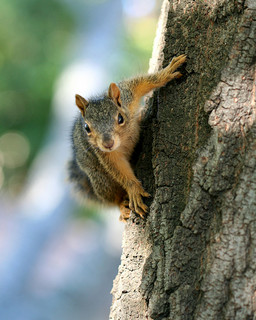Tree Branches Provide a Pest Travel Route to Your Roof
By Chris Williams on April 28, 2014.

Squirrels and other wildlife can enter your home by way of tree branches.
Tree Branch Question
We’re starting to do some spring cleanup around our yard. I’ve been trying to tell my husband that he needs to prune back the tree branches that are touching the roof to keep pests from getting into the house. He doesn’t understand how the branches are a problem. Can you help explain it to him? – T.S., Durham NH
Answer
Sure can. Many of our indoor pests, both insects and rodents, come in from the outside. Often they enter through gaps around doors or windows, but the roofline is a major entry point. There are always cracks and crevices around eaves and soffits that let insects into the attic space (and from there into living areas). Insects can climb up the outside of your house to reach the roofline, but they also follow branches that touch the roof.
- Ants – Overhanging branches provide a way for carpenter ants and other outside foraging ants to get into your home. The ants don’t even know your roof is at the end of that branch they’re traveling, but once they find their way inside and find food, they leave a trail from the tree to the food that other ants will follow as well.
- Animals – Rodents like squirrels and mice travel from trees onto the roof and sometimes chew their way into the attic. Animals that are living in your attic will use the tree branches as their two-way highway to get up to their attic nest and back down to the ground where they forage for food. Where roof rats are a problem, branches are the main way that these rats get into homes. Roof rats are very agile and spend most of their time in trees and up off of the ground.
- Fall Invading Insects – Many of those pests that come in from outside enter at the roofline to spend the winter in our homes. Stink bugs, cluster flies, lady beetles, and seed bugs will climb walls or follow branches in their search for protected places to spend the winter.
Shrubs and Vines are a Problem, Too
If you have vines like English ivy growing up the outside walls of your home, you are also attracting pests. The vines may have aphids feeding on them, which in turn, are tended by ants. The ants “farm” the aphids for the honeydew that they exude. Vines also provide shelter for pests. Overwintering insects will cluster in the ivy by the thousands. Birds will also nest in ivy.
Aphids (and their ants) are commonly found on flowering shrubs planted around the foundation of homes. Trim shrubs back so that their branches don’t touch the house and provide a travel route for ants.
Finally, if you have heavy groundcover around the foundation of your home, you should thin it out, trim it back, or remove it. Insects hide in it and rodents, especially, like to burrow unseen under the cover of heavy vegetation.
Photo credit: John-Morgan / Foter / Creative Commons Attribution 2.0 Generic (CC BY 2.0)